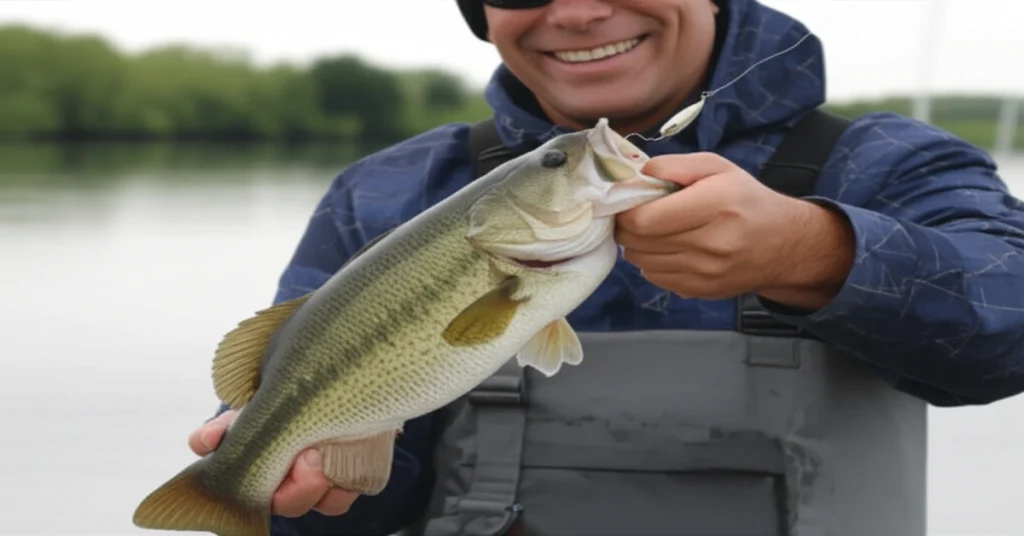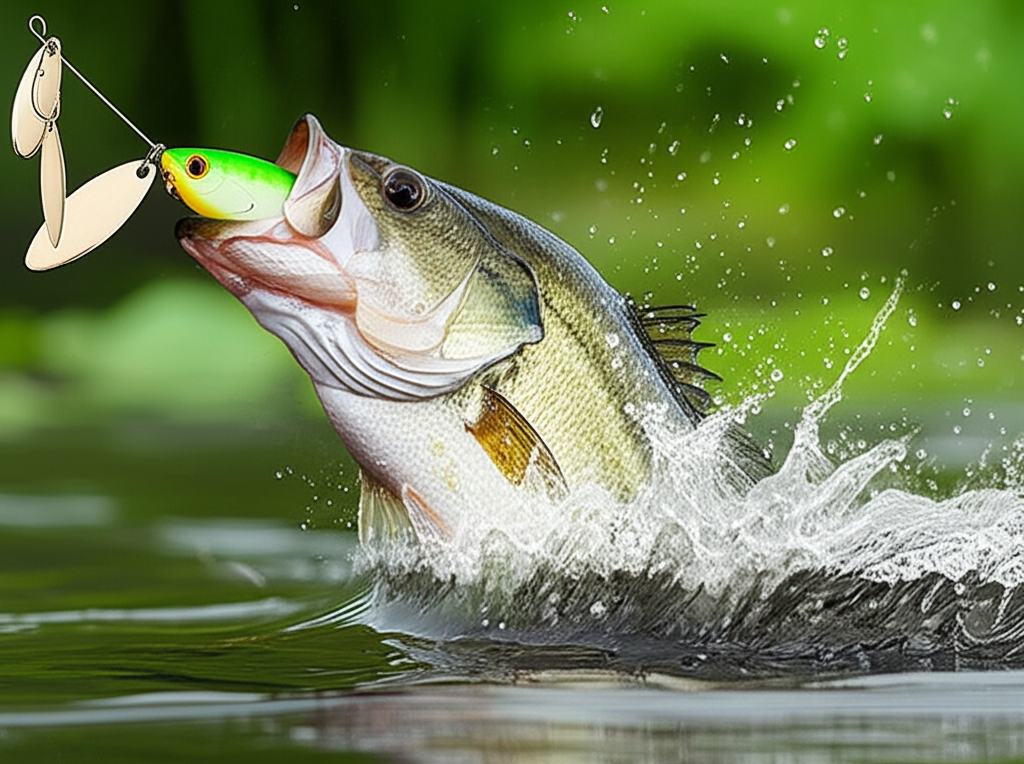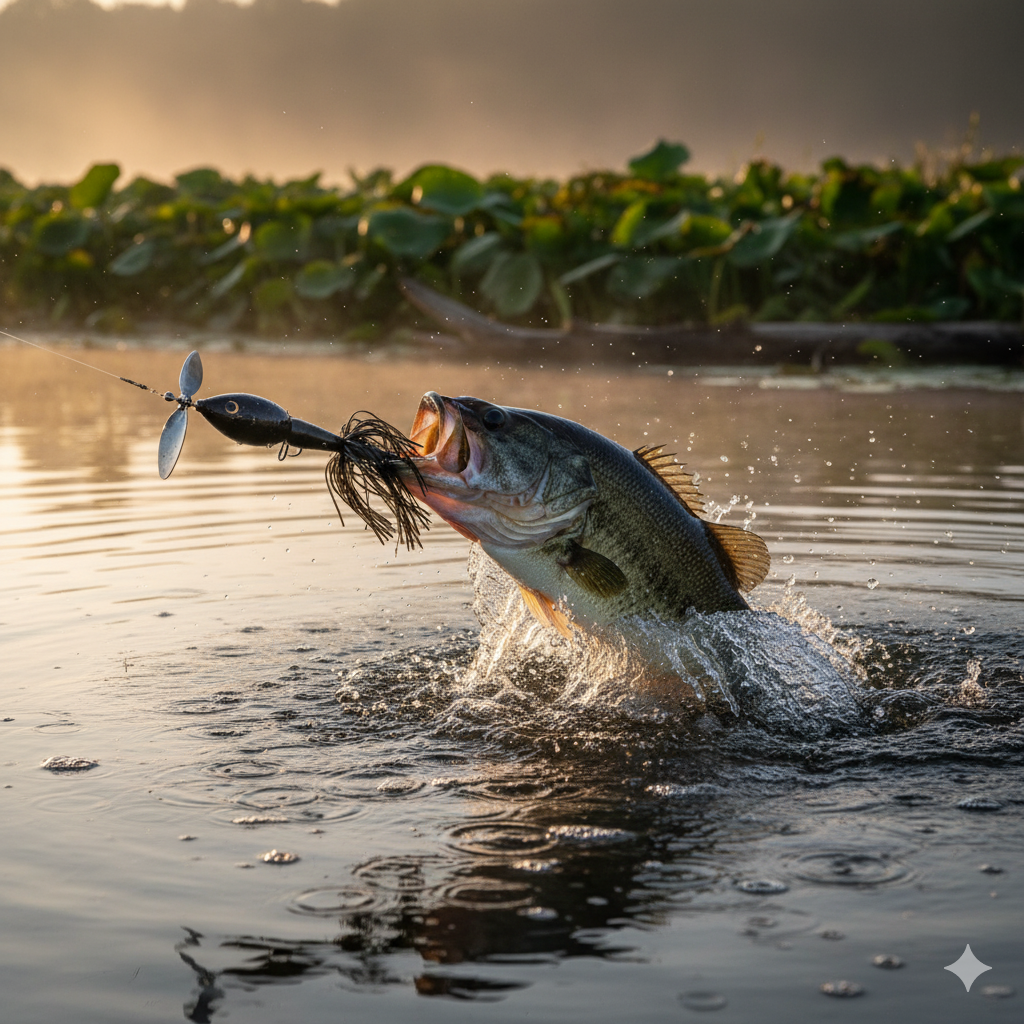Spinnerbait Fishing Techniques: The Ultimate Pro Guide
Ever stared at a tackle box full of lures and felt completely overwhelmed, wondering which one will actually get a bite? You’re not alone. For countless anglers, the key to unlocking consistent success lies in mastering one of the most versatile lures ever created: the spinnerbait. This guide is your definitive resource for mastering spinnerbait fishing techniques, transforming this simple piece of metal and silicone from just another lure into your go-to fish catcher. We will break down everything from the fundamental mechanics to advanced strategies that will have you out-fishing your competition and putting more bass in the boat.
This comprehensive spinnerbait fishing guide is designed to elevate your angling prowess, regardless of your current experience level. We’ll move beyond simply casting and reeling, diving deep into the nuances that separate beginners from experts. You will learn to read the water, select the perfect spinnerbait for any condition, and apply sophisticated spinnerbait presentation techniques that trigger aggressive strikes from even the most hesitant fish. Prepare to build confidence and develop a new level of mastery over this iconic lure.
Table of Contents
- What is spinnerbait fishing techniques?
- Key Benefits and Importance
- Complete Step-by-Step Guide
- Expert Tips & Best Practices
- Common Mistakes to Avoid
- Advanced Strategies for 2024/2025
- Essential Tools & Resources
- Frequently Asked Questions
What is spinnerbait fishing techniques?
Spinnerbait fishing techniques are the specific methods and skills an angler uses to present and retrieve a spinnerbait lure to attract and catch predatory fish, primarily bass. These techniques encompass everything from lure selection and casting accuracy to the speed and action imparted on the lure during its return to the angler.
Effectively, these are more than just random actions; they represent a complete system for using this unique lure. Mastering various spinnerbait retrieval techniques allows you to mimic different types of prey, from a fleeing baitfish to a slow-crawling crawdad. Understanding different spinnerbait fishing methods is crucial for adapting to changing weather, water clarity, and fish behavior. This comprehensive spinnerbait fishing guide covers a wide array of spinnerbait presentation techniques, spinnerbait fishing strategies, and how to control spinnerbait retrieve speeds. From spinnerbait fishing basics for the novice to spinnerbait fishing advanced tactics for the pro, developing these spinnerbait fishing skills is a cornerstone of becoming a versatile angler.
Key Components
- Blades: The engine of the lure, blades create flash and vibration to attract fish from a distance. The shape (Colorado, willow, Indiana) dictates the amount of thump and flash.
- Wire Frame: This V-shaped arm provides structure, creates vibration, and helps the lure run true while deflecting off cover like wood and rock.
- Head & Skirt: The lead head provides weight for casting and depth control, while the silicone or rubber skirt creates a lifelike profile and pulsating action in the water.
- Hook: The business end of the lure, usually a single, sturdy hook that is partially hidden by the skirt, making it relatively weedless.
Why spinnerbait fishing techniques Matters: Key Benefits
Mastering spinnerbait fishing techniques is not just about learning to use one lure; it’s about unlocking a tool that excels in a vast range of situations where other lures fail. Its unique design allows it to be fished effectively from just below the surface to the deepest ledges, through thick vegetation and around hard cover. This versatility means you spend less time changing lures and more time with your line in productive water, drastically increasing your efficiency and catch rate throughout the year.
Unmatched Versatility
One of the primary benefits of the spinnerbait is its incredible adaptability. By simply changing your retrieve speed or the blade configuration, you can alter the lure’s action to match the mood of the fish. For example, on a windy, overcast day, a double Colorado blade spinnerbait retrieved slowly provides maximum vibration, allowing bass to hone in on it in low-visibility conditions. On a sunny day in clear water, a double willow leaf blade spinnerbait retrieved quickly creates immense flash, mimicking a panicked school of baitfish and triggering reaction strikes.
Superior Water Coverage
Spinnerbaits are search baits, designed to be cast and retrieved continuously to cover large areas of water efficiently. This makes them the perfect tool for locating active fish on a new body of water or quickly dissecting large flats, long points, or expansive weed beds. An angler proficient in spinnerbait fishing techniques can analyze hundreds of yards of shoreline in the time it might take a bottom-contact angler to fish a single small area. This efficiency is critical in tournament situations and for maximizing short fishing windows.
“The spinnerbait isn’t just one lure; it’s a dozen lures in one. The angler who understands how to change its personality with retrieve speed and rod movement is the one who consistently catches fish when nobody else can.”
Complete Guide to spinnerbait fishing techniques – Step-by-Step
Following a systematic approach is the fastest way to build proficiency with these powerful spinnerbait fishing methods. This step-by-step process breaks down the core elements, from initial selection to the final retrieve, setting you up for success on the water.
Step 1: Selecting the Right Spinnerbait
Your success begins before you even make a cast. Choosing the right spinnerbait involves considering three factors: water clarity, available forage, and water depth. A poor choice here can render even the best technique ineffective.
- Blade Choice: For muddy or stained water, use round Colorado blades for maximum vibration. For clear water, use slender willow blades for maximum flash and speed. Indiana blades offer a middle ground.
- Color Selection: In clear water, use natural colors like shad or translucent patterns. In stained water, use bright colors like chartreuse and white to increase visibility.
- Weight Selection: Use 1/4 to 3/8 oz for shallow water (1-5 feet). Use 1/2 to 1 oz for deeper water (6-20+ feet) or for fishing in windy conditions.
Step 2: Making the Targeted Cast
A spinnerbait excels when fished around cover. The goal is not to cast into open water, but to make precise casts that bring the lure past, through, or over potential fish-holding objects. Focus on high-percentage targets like submerged logs, dock pilings, weed lines, and rock piles. Try to make your lure bump into the cover; this erratic deflection often triggers a predatory strike. This is a core tenet of effective spinnerbait fishing strategies.
Step 3: Executing Foundational Retrieves
The retrieve is where the magic happens. This is the heart of all spinnerbait retrieval techniques. Start by mastering these three fundamental retrieves.
- The Slow Roll: The most common and effective technique. Cast out, let the bait sink to your desired depth, and begin a slow, steady retrieve that keeps the blades barely turning. This is deadly for inactive fish and in colder water.
- Burning: The opposite of the slow roll. Reel the spinnerbait as fast as you can just beneath the surface, creating a “bulge” on the water. This triggers aggressive reaction strikes from active fish, especially in warmer water.
- The Yo-Yo: Cast the lure, let it fall to the bottom, then lift your rod tip from the 9 o’clock to the 11 o’clock position, letting the blades flutter. Reel up the slack as you lower the rod and repeat. This mimics a dying baitfish and is excellent for targeting fish on deep structure.
Expert Tips & Best Practices for spinnerbait fishing techniques
Adhering to best practices accelerates the learning curve and helps you avoid common frustrations. These spinnerbait fishing tips are divided into foundational advice for newcomers and more nuanced strategies for experienced anglers looking to refine their skills.
For Beginners:
- Always Use a Trailer Hook: Bass often swipe at a spinnerbait and miss the main hook. Adding a trailer hook will dramatically increase your hook-up ratio, converting short strikes into landed fish. This is one of the most crucial spinnerbait fishing basics.
- Tune Your Bait: If your spinnerbait runs on its side, the wire frame is bent. Gently bend the wire arm back until the lure runs straight and true. A properly tuned bait is essential for effective spinnerbait presentation techniques.
- Match the Hatch: Pay attention to the primary forage in the lake. If bass are feeding on small bluegill, use a spinnerbait with green and orange in the skirt. If they’re chasing shad, a white or silver pattern is best.
For Advanced Users:
- Helicoptering Down Bluffs: When fishing steep rock walls or bluff ends, cast parallel to the bank and let the spinnerbait fall on a semi-slack line. The blade will spin as it descends, creating a “helicopter” effect that is irresistible to suspended bass. This is a key spinnerbait fishing advanced technique.
- Bulging the Surface: In calm, shallow water, burn a double-willow spinnerbait so it wakes just under the surface. The bulge it creates mimics a fleeing baitfish and can draw explosive topwater-style strikes without the missed hook-ups of a traditional topwater lure.
Advanced spinnerbait fishing techniques Strategies for 2024/2025
As fishing pressure increases, bass become conditioned to standard presentations. Staying ahead of the curve requires adopting advanced, modern spinnerbait fishing techniques. These cutting-edge approaches can trigger bites from wary, educated fish.
Night Fishing with Oversized Colorado Blades
Night fishing for bass is a growing trend, and spinnerbaits are a top producer after dark. Instead of relying on sight, bass feed almost entirely by feeling vibrations with their lateral line. The advanced strategy for 2024/2025 is to use a heavy (3/4 to 1 oz) black spinnerbait with a single, oversized #7 or #8 Colorado blade. The immense “thump” of this large blade acts as a beacon, drawing bass in from long distances in complete darkness. Slow-roll this rig along deep weed lines or rocky points for giant summer bass.
Downsizing for Finesse Situations
When faced with ultra-clear water, high sun, or intense fishing pressure, big, flashy spinnerbaits can spook more fish than they attract. The modern counter-move is to apply finesse spinnerbait fishing techniques. Use a small 1/8 or 3/16 oz spinnerbait, often called a “finesse spinnerbait,” on spinning tackle with 8-10 lb fluorocarbon line. This subtle presentation has a smaller profile and less flash, appealing to finicky bass that are ignoring standard offerings. This is a top-tier tactic for developing your spinnerbait fishing skills.
Essential Tools & Resources for spinnerbait fishing techniques
Having the right gear is fundamental to properly executing the techniques discussed in this guide. The wrong setup can hinder your ability to feel the bait, make accurate casts, and fight fish effectively. Here are the essential tools and resources.
Recommended Tools:
- Rod: A 7’0″-7’3″ medium-heavy power, moderate-fast action casting rod. This provides the ideal blend of casting distance, accuracy, and shock absorption.
- Reel: A casting reel with a gear ratio between 6.3:1 and 7.5:1. This range is versatile enough to handle both slow-rolling and burning techniques effectively. A faster reel helps pick up slack quickly when a fish bites and runs toward you.
- Line: 15-20 lb test fluorocarbon line is the best all-around choice. Its low visibility, abrasion resistance, and low stretch make it perfect for most spinnerbait applications. In heavy vegetation, 30-40 lb braided line can also be used.
Additional Resources:
- Trailer Hooks: A non-negotiable accessory. Always have a pack of trailer hooks that match the size of your primary spinnerbait hook.
- Lake Mapping Apps: Services like Navionics or Humminbird FishSmart allow you to study contour maps and identify key structures like points, humps, and channel swings where spinnerbaits excel before you even launch your boat.
Frequently Asked Questions About spinnerbait fishing techniques
Q1: What are the most effective spinnerbait fishing methods for different seasons?
Answer: The best spinnerbait fishing methods vary significantly with the seasons. In Spring, as bass move shallow, use a 3/8 oz spinnerbait with a mix of Colorado and willow blades in chartreuse and white around spawning flats. In Summer, burn a 1/2 oz double-willow spinnerbait over submerged grass or slow-roll a heavy 1 oz version on deep river ledges. In Fall, focus on mimicking fleeing baitfish with shad-colored spinnerbaits retrieved quickly around points and creek channels. In Winter, a slow-rolling spinnerbait fishing technique with a single Colorado blade is one of the few ways to trigger sluggish bass in cold water.
Q2: When should I choose willow blades versus Colorado blades?
Answer: Choose willow blades when you need speed and flash. They are best for clear water, sunny days, and when you want to burn the bait quickly under the surface. Choose Colorado blades when you need vibration and lift. They are superior in stained or muddy water, on cloudy days, at night, and for slow-rolling presentations where the deep “thump” helps fish find the lure.
Q3: Does the wire thickness on a spinnerbait matter?
Answer: Absolutely. A thinner wire (e.g., .028 inches) will vibrate more, which can be an advantage in some situations. However, it is also more likely to break after catching several fish. A thicker wire (e.g., .035 inches) is more durable and better for fishing in heavy cover, but it produces slightly less vibration. For general use, a medium-gauge wire offers a good balance of vibration and durability.
Q4: What’s the single most important tip for a beginner starting with spinnerbait fishing?
Answer: The most critical piece of advice from this spinnerbait fishing guide for a beginner is to maintain contact with the lure. You must be able to feel the blades vibrating through your rod. If you don’t feel that distinct “thump-thump-thump,” you are either reeling too slowly, or your bait is fouled with weeds. A spinnerbait that isn’t spinning is just a piece of metal and won’t get bites. Focus on finding a retrieve speed that keeps those blades turning consistently.
Conclusion: Master spinnerbait fishing techniques for Long-term Success
The spinnerbait is far more than a simple lure; it’s a complex and dynamic tool that can dominate in nearly any condition when the right spinnerbait fishing techniques are applied. We’ve covered the full spectrum, from selecting the right components and making targeted casts to executing a variety of retrieves and avoiding common pitfalls. The key takeaways are to always match your lure to the conditions, never stop experimenting with your retrieve, and pay close attention to the details like hook sharpness and proper gear.
As you move forward, continue to practice and refine these methods. The future of angling will reward those who develop deep spinnerbait fishing skills and adapt their spinnerbait fishing strategies to changing environments. By applying the spinnerbait retrieval techniques, spinnerbait fishing methods, and spinnerbait presentation techniques outlined in this guide, you are well on your way to not just catching more fish, but becoming a more complete and successful angler for years to come.
Ready to Master spinnerbait fishing techniques?
Don’t just read about it, do it! Grab a 3/8 oz white and chartreuse double-willow spinnerbait, head to your local lake, and practice the ‘slow roll’ technique along the first weed line you find. Apply what you’ve learned today and experience the results firsthand!
Related Articles You Might Find Helpful:
- Advanced Spinnerbait Retrieval Techniques for Pressured Bass
- How to Choose the Right Fishing Line: A Complete Guide
- Top 5 Lures for Catching Bass in Muddy Water
What’s Your spinnerbait fishing techniques Experience?
What’s your go-to spinnerbait color and blade combination? Share your biggest spinnerbait catch or a favorite tip in the comments below!
Note: This guide reflects current best practices and is updated regularly to ensure accuracy. Last updated: October 17, 2023



